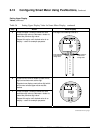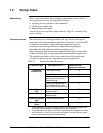
ST 3000 Release 300 and SFC Model STS103 User’s Manual 6/08
122
6.13 Disconnecting SFC
Considerations
• Be sure a “#” character does not appear on the right side of the SFC
display indicating that the transmitter may be in its current output
mode, or the SFC has detected a non-critical status condition.
– Example:
PTLRV
nH
3011
i
1
25
.ØØØØ O
#
If the # character is on the display, press the [OUTPUT] key and then the
[CLR] key to remove the transmitter from the current output mode, or
press the [STAT] key to check the operating status of the transmitter.
– Example:
INPUT
J
OUT-
PUT
PTOUT 30111P#
FC WOSING.RK ..
PTOUT
%
30111
5
.ØØØ
P#
CLR
(NO)
PTOUT 30111P#
FC WOSING.RK ..
LIN DP
.Y. .READ
T 011P3
• Be sure to store all changes in the transmitters non-volatile memory by
pressing the [SHIFT] key and then the [ENTER] key.
– Example:
^
SHIFT
LIN DP
FT–SHI
T 011P3
NON-VOL
ENTER
(Yes)
PTL I N 3011DP
FC WOSING.RK ..
PTL I N 3011
NO VO ATLNDATA ILE
DP
LIN DP
.Y. .READ
T 011P3
WARNING
• Be sure to disconnect the SFC leads from the transmitter before
unplugging them from the SFC.
• Be sure the SFC is disconnected from a transmitter in the analog
mode before returning the loop to the automatic operating mode.


















